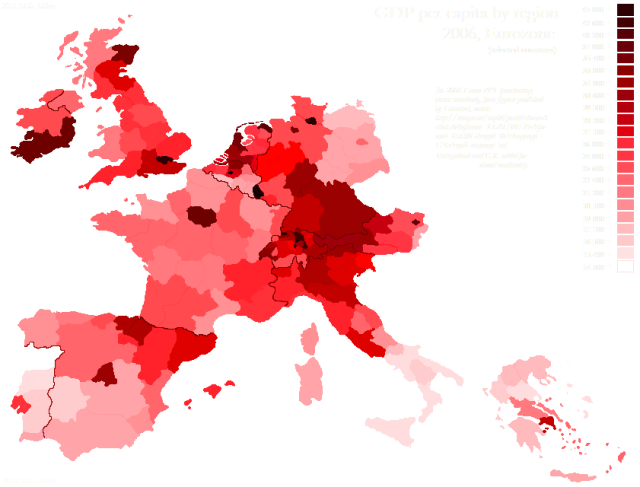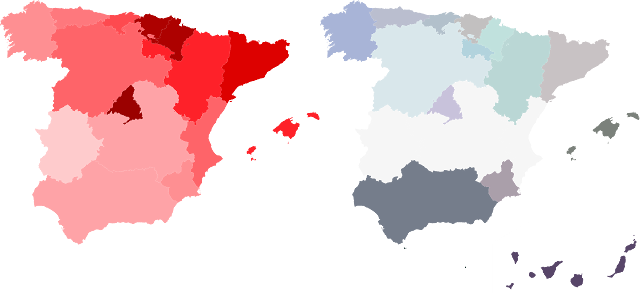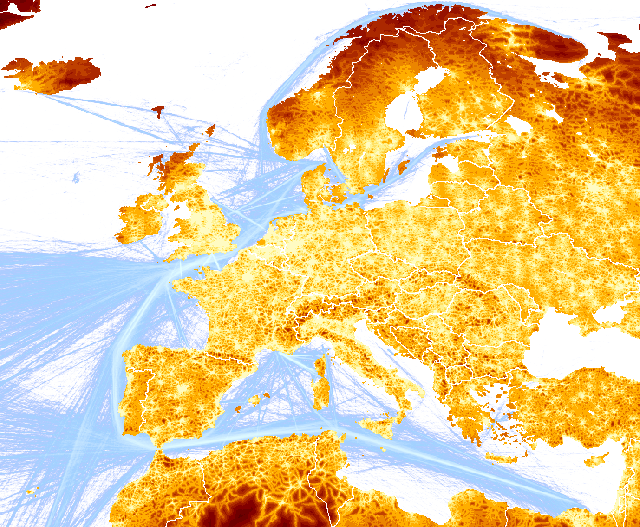Commenter M.G. Miles posted a link to a map she made showing 2006 GDP per capita in the Eurozone (plus Switzerland and the UK) at the largest subnational level.

Since she offered it up for comparison, I thought I’d show the GDP per capita and PISA maps side by side for both Spain and Italy:

 I must say, it is an interesting comparison. While there is a clear correlation between the test scores and the economic indicator, there are definitely exceptions and outliers. Furthermore, many of the outlier provinces have interesting characteristics that could act as confounding factors.
I must say, it is an interesting comparison. While there is a clear correlation between the test scores and the economic indicator, there are definitely exceptions and outliers. Furthermore, many of the outlier provinces have interesting characteristics that could act as confounding factors.
It is clear that there is a boost to regional GDP per capita to be the province that hosts the capital city. Madrid and Lazio, the Italian region containing Rome, both have higher GDP per capita numbers than the surrounding provinces, despite the fact that they both had lower test scores than at least some of the those same provinces. Looking out at other European countries, we can see that this effect holds as the provinces containing Lisbon, Paris, Dublin, London, Brussels, Vienna, and Athens all have the highest performances of their countries’ respective provinces.
Furthermore, there seem to be some linguistic outliers. The province in Italy with the best economic performance is South Tyrol, which is majority German-speaking. While the map shows it with lower test scores than its neighbor to the south, Trent, the scores from that province were labeled as belonging to Bolzano, the Italian-speaking provincial capital. We can similarly see that the Basque-speaking regions and Catalan-speaking Catalonia of Spain perform well economically despite having test scores that are not out of the ordinary.
Others, such as Castile-Leon in Spain and Apulia Italy seem to underperform economically relative to their test scores, the former being the highest scoring province in Spain and the latter the highest scoring region in southern Italy. Despite those outliers, there is a pretty clear correlation between the two indicators.
Update
This exercise reminded me of two other interesting maps. The first is a “global urbanisation and accessibility map” done by the European Commission and the World bank. The brighter an area on land, the quicker one could reach a city of population 50,000 or more using conventional land transportation and the bright lines in the bodies of water are major trade lanes. Here is the European section of the map:
 The second comes from Oliver H. Beauchesne, who used biblometric data from his firm, Science-Metrix to show visually the quantity of scientific collaborations between different cities throughout the world, linking cities according to the locations of institutions of coauthors on different scientific papers. The global pattern is interesting in itself:
The second comes from Oliver H. Beauchesne, who used biblometric data from his firm, Science-Metrix to show visually the quantity of scientific collaborations between different cities throughout the world, linking cities according to the locations of institutions of coauthors on different scientific papers. The global pattern is interesting in itself:

Centering on Europe, which is itself the largest center of inter-city scientific collaborations by Beauchesne’s map, we can see with greater detail where the real centers of scientific collaboration are:

Unlike the accessibility map, where, though there are differences in transportation infrastruction between regions that are related to economic activity, the main variation appears to be a function of the presence of mountainous terrain, Beauchesne’s map shows a much more stark, hierarchical picture, literally so in the case of countries like France where the capital city plays a central role in the country’s intellectual infrastructure.
Looking at Spain and Italy in particular, we can see some interesting dynamics:

Here we see that Spain, unlike France, is not completely centered around Madrid. Barcelona seems to be a center of fairly intense collaborations at a relatively local level and also seems to have stronger ties to the French research community than Madrid does. It’s also clear that in the south of Spain, the connections to the two centers of Madrid and Barcelona are strong compared to relatively weak local connections. In many ways, the research communities in the south seem as satellites to the more important cities of Spain, a trend that is even stronger in Italy:
 Here we see a country where the undisputed center of scientific collaboration is Milan and the surrounding area, but unlike France where cities across the country show their strongest links to Paris, Milan is simply a concentration of activity in a broader, more interconnected web, a web that is strong throughout the northern parts of the country. It is in the south, Sicily and Calabria in particular, that we see a lack of interconnectivity–the bulk of collaborations are with cities in the north.
Here we see a country where the undisputed center of scientific collaboration is Milan and the surrounding area, but unlike France where cities across the country show their strongest links to Paris, Milan is simply a concentration of activity in a broader, more interconnected web, a web that is strong throughout the northern parts of the country. It is in the south, Sicily and Calabria in particular, that we see a lack of interconnectivity–the bulk of collaborations are with cities in the north.



Reluctant Apostate, is it possible to embed maps in a comment here? I have some things that really struck me as lining up with thse last comparative maps you show. They are historical, going back centuries in some cases. I’d like to share them here –is it possible?
Yes, I believe it should work, but only the first 610 pixels in width will show up visually as part of the comment.
Also, though it is of absolutely no consequence to me what gender anyone thinks I am on the internet, I wouldn’t want you to possibly feel embarassed by referring to me as the wrong one: I am in fact a ‘she.’
My apologies. The requisite changes have been made.
Reluctant Apostate, instead of potentially polluting your comments section with failed attempts, I’ve put up some maps comparing variables throughout Italy’s history at the regional level here:
http://thosewhocansee.blogspot.com/2011/10/nation-and-nations.html
May I include your PISA score map in my collection with a link, or would you prefer I just put up a link to it?
Thanks and sorry to come back so late to this post, I was severed from the internet for about a month there.
Feel free to use any of the maps here.